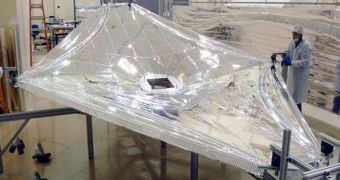Designing and building the world's largest, space-based observatory to date – the James Webb Space Telescope – is no easy task. Numerous technologies have to be produced specifically for this mission, and the sunshield that will protect the spacecraft from stray solar radiation is one of them. Thus far, tests on the new instrument have been extremely successful, with the materials included in the design behaving admirably, experts say. Scale models of the sunshield have revealed that the teams of engineers involved in the project have been doing a phenomenal job, ScienceDaily reports.
The JWST, scheduled for launch in a few years, as a replacement for the aging Hubble Space Telescope, needs to be able to spot objects giving off a faint light signature in the infrared wavelength spectrum. These celestial bodies are most likely located billions of light-years away, in the early Universe, and so the observatory's detectors need to be extremely accurate. They also need to be cooled to cryogenic temperatures, of just under 50 degrees Kelvin (-370°Fahrenheit, or -223°Celsius). In order for this to happen, the sunshield must effectively block all incoming radiation from the Sun. This will stop stray photons from wandering into the detectors, hampering accurate observations.
The new instrument will feature a five-layer, tennis court-sized sunshield, whose job is to withstand some 100,000 thermal watts of solar heat. The experts in charge of constructing the actual device say that the heat limit allowed to pass through to the other side is below one tenth of a watt. This means that the shield is capable of a million-to-one reduction, which is absolutely amazing. Because there is no cryogenic chamber in the world large enough to accommodate the full-size shield, experts have designed three smaller ones (1/3 scale), which they are currently testing rigorously.
“The flight sunshield will be deployed and visually inspected prior to flight, but only a computer simulation of its thermal performance will be used to determine if it's ready to launch. This is very similar to wind tunnel testing of large aircraft. Most aircraft, especially large commercial airliners, are simply too large to undergo full-size testing. Computer models, which extrapolate the test data from smaller scale model wind tunnel tests, are used to verify final design and predict the full size aircraft's performance. Our Webb sunshield 1/3-scale model test is a very similar approach,” says NASA Goddard Space Flight Center (GSFC) Webb telescope Sunshield Manager Keith Parrish.

 14 DAY TRIAL //
14 DAY TRIAL //